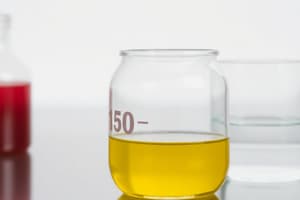Podcast
Questions and Answers
What is the primary purpose of bonding in chemistry?
What is the primary purpose of bonding in chemistry?
- To achieve stability by sharing electrons (correct)
- To enhance the color of substances
- To break down chemical bonds
- To create new substances
Which of the following best describes a chemical reaction?
Which of the following best describes a chemical reaction?
- Production of new substances when chemicals interact (correct)
- Atoms achieving stability by sharing electrons
- Changing the physical state of substances
- Breaking down of substances into smaller particles
What critical thinking skills can be developed through understanding stoichiometric ratios?
What critical thinking skills can be developed through understanding stoichiometric ratios?
- Artistic creativity
- Musical abilities
- Problem-solving skills (correct)
- Physical strength
In chemistry, what does stoichiometry deal with?
In chemistry, what does stoichiometry deal with?
What is NOT a possible outcome of embracing fundamental chemistry principles?
What is NOT a possible outcome of embracing fundamental chemistry principles?
Which activity would most likely help in exploring chemistry?
Which activity would most likely help in exploring chemistry?
What is the role of an atom in chemistry?
What is the role of an atom in chemistry?
How are molecules formed?
How are molecules formed?
What is the primary function of the periodic table in chemistry?
What is the primary function of the periodic table in chemistry?
What is a molecule made up of?
What is a molecule made up of?
Which part of an atom determines its chemical properties?
Which part of an atom determines its chemical properties?
What do the periods in the periodic table represent?
What do the periods in the periodic table represent?
Flashcards are hidden until you start studying
Study Notes
Exploring Chemistry for Ninth Graders
As you enter your ninth grade science journey, one of the most fascinating subjects awaits with open arms – chemistry! In this engaging exploration, we'll dive into the fundamentals, experiments, and real-world applications that form the foundation of chemistry knowledge.
Matter & Atoms
At its core, chemistry is all about matter and how it behaves. Before diving deeper, let's familiarize ourselves with two central concepts: atoms and molecules. While you may have heard of them before, understanding their role will help lay the groundwork for everything you learn during your chem-adventure.
- Atom: A small particle making up everything around us. It consists of protons, neutrons, and electrons.
- Molecule: Groups of atoms bonded together, forming unique chemical compounds like water (H₂O), sodium chloride (NaCl), and glucose (C₆H₁₂O��6).
Periodic Table
Organizing the elements in order based on atomic number, the periodic table becomes our trusty guide through the world of chemistry. Once you understand the basic structure, locating various elements and identifying patterns become easier and more enjoyable tasks.
- Elements: Substances made from just one type of atom.
- Periods: Horizontal rows of the periodic table contain elements organized by increasing atomic numbers.
- Groups: Vertical columns of the periodic table containing similar kinds of elements.
Bonding & Reactions
In Class 9 chemistry, having an introduction to bonding and chemical reactions is crucial. These processes allow us to understand the formation and breakdown of chemical bonds between atoms resulting in interesting reactions like rusting iron, synthesizing sugars from carbohydrates, and even the combustion of fuels.
- Bonding: The process whereby atoms share electrons to achieve stability.
- Reaction: When chemicals interact and undergo changes, producing new substances.
Stoichiometry
While it sounds fancy and math-related, stoichiometry allows us to determine the quantities of reactants and products involved in chemical reactions. Understanding stoichiometric ratios can assist in predicting reaction outcomes while learning critical thinking skills essential in problem-solving.
- Stoichiometry: Quantitative relationships among reactants and products in balanced equations.
Remember, embracing these fundamental principles along with hands-on activities and the curiosity they spark will make exploring chemistry in ninth grade both enriching and enjoyable. So, put on those lab coats, pick up some test tubes, and embark on a scientific adventure waiting right outside your classroom door!.
Studying That Suits You
Use AI to generate personalized quizzes and flashcards to suit your learning preferences.




